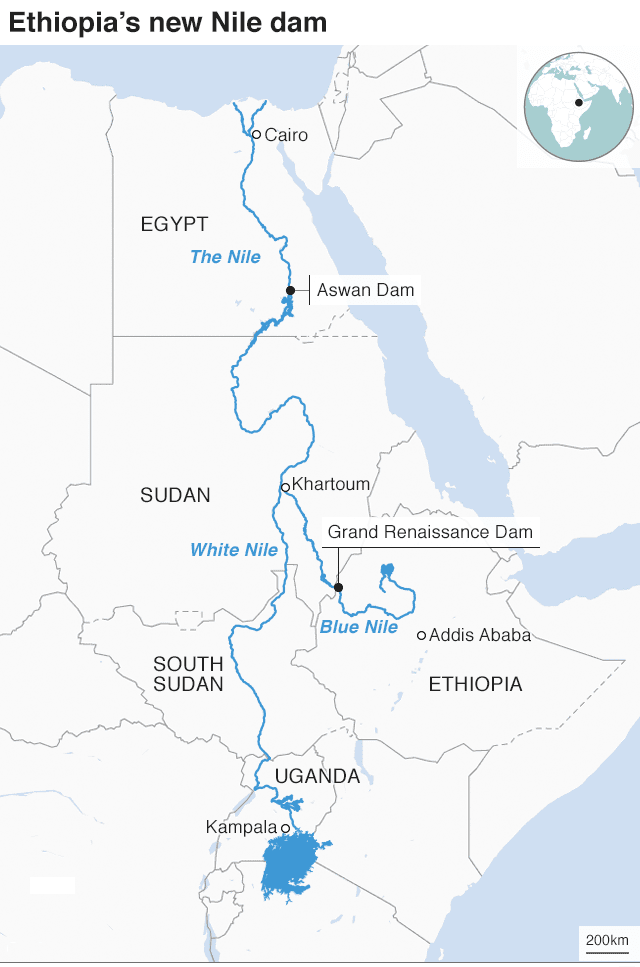Egypt-Ethiopia Conflict on GERD | 26 May 2020
Why in News
Recently, Egypt has announced that it is willing to resume negotiations with Ethiopia and Sudan, concerning the Grand Ethiopian Renaissance Dam (GERD).
- The dam is located on River Blue Nile (a tributary of River Nile) in Ethiopia and is the centre of a dispute involving several East-African countries, dependent on the river’s waters.
Key Points
- Background:
- Ethiopia began the construction of the GERD in 2011 on the Blue Nile that runs across one part of the country.
- After completion, the dam hydropower project will be Africa’s largest.
- Egypt has objected to the construction of the dam and proposed a longer timeline for the project.
- Sudan has also been involved due to its location.
- The Nile is an important water source in the region so there are concerns that this dispute may evolve into a full-fledged conflict between Egypt and Ethiopia.
- For the past four years, tri-party talks between Egypt, Ethiopia and Sudan have been unable to reach agreements.
- Recently, the USA has stepped in to mediate.
- Ethiopia began the construction of the GERD in 2011 on the Blue Nile that runs across one part of the country.
River Nile
- The name Nile is derived from the Greek word Neilos (Latin: Nilus), meaning a valley or a river valley.
- It is the longest river in the world and is called the father of African rivers. It has a length of about 4,132 miles and drains an area estimated at 1,293,000 square miles.
- It rises south of the Equator and flows northward through northeastern Africa to drain into the Mediterranean Sea.
- The Nile River forms an arcuate delta as it empties into the Mediterranean Sea. Deltas with triangular or fan-shape are called arcuate (arc-like) deltas.
- The Nile is formed by three principal streams: the Blue Nile, the Atbara, and the White Nile.
- Drainage: Parts of Tanzania, Burundi, Rwanda, the Democratic Republic of the Congo, Kenya, Uganda, South Sudan, Ethiopia, Sudan, and the cultivated part of Egypt.
- Dam’s Importance for Ethiopia:
- Ethiopia believes that the dam will generate approximately 6,000 megawatts of electricity after completion.
- This dam will reduce electricity shortages and help the country’s manufacturing industry.
- It will also enable Ethiopia to supply electricity to neighbouring nations and earn revenue in exchange.
- Neighbouring countries like Kenya, Sudan, Eritrea and South Sudan also suffer from electricity shortages and they can also benefit from the hydropower project if Ethiopia decides to sell electricity to them.
- Ethiopia sees the dam as a matter of national sovereignty and the dam project does not rely on external funding and relies on government bonds and private funds to pay for the project.
- Ethiopia believes that the dam will generate approximately 6,000 megawatts of electricity after completion.
- Cause of Conflict:
- The hydropower project may just allow Ethiopia to control the Nile’s waters, and this concerns Egypt because it lies downstream on the Nile.
- The dam would jeopardise food and water security and livelihoods of ordinary Egyptian citizens.
- Egypt has also written to the United Nations Security Council (UNSC) concerning the matter and has also implied that the dam would cause armed conflict between the two countries.
- Egypt has proposed a longer timeline because it does not want the water level of the Nile to drastically drop as the dam reservoir needs plenty of water to fill in the initial stages.
- The longer it takes to fill the reservoir, the less impact will be there on the water level of the river.
- Sudan too believes that Ethiopia having control over the river through the dam may affect the water supplies of the country. It has proposed joint management of the dam.
- Sudan is likely to benefit from the power generated by the dam.
- The regulated flow of the river will save Sudan from serious flooding in August and September.
- There is a possibility that the conflict would threaten the vital international trade route through the Suez Canal and along the Horn of Africa.
- The hydropower project may just allow Ethiopia to control the Nile’s waters, and this concerns Egypt because it lies downstream on the Nile.
Way Forward
- To solve the conflict peacefully, mediation and facilitation by the neighbouring countries and the international bodies are necessary.
- In case, the attempt to resolve the conflict does not work out by facilitating negotiations between the conflict parties, then a compensation method can be adopted which would need the countries to compensate each others’ losses.
- All countries involved in the issue need to peacefully resolve the issue so that they can reap the advantages of the dam and their peace and security is restored again.

